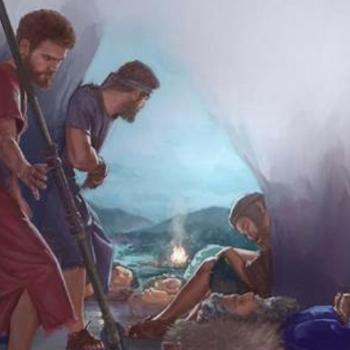Jesus said to [Thomas], “Have you come to believe because you have seen me? Blessed are those who have not seen and have believed” (John 20:29).
For two thousand years, St. Thomas has been remembered more for his doubt than for his bravery. Every Easter we hear from St. John about how Thomas steadfastly refused to believe that Christ had risen from the dead “unless I see the mark of the nails in his hands and put my finger into the nail marks and put my hand into his side” (John 20:25). Rarely do we remember that John also recorded that Thomas was the apostle who was ready to die with Jesus: “Thomas … said to his fellow disciples, ‘Let us also go, that we may die with him’” (11:16).
When I was ten years old, I needed to have my tonsils and adenoids removed at a local children’s hospital. In preparation for the surgery, I was given a tour of the facility and told what was going to happen. I was enthralled by the idea that following the surgery I would be taken from recovery to a private room on a rolling bed. I eagerly looked forward to sitting on the bed and waving to people as I was rolled through the halls of the hospital.
I still remember what happened when the day finally arrived. As I was being pushed down the hall, I recalled my earlier desire. In that moment however, I discovered that I quite literally couldn’t lift my head from my pillow, much less sit up and wave at onlookers. It was a lesson I never forgot: we very often like to imagine ourselves responding nobly and heroically to adversity, only to discover in the moment that we’re barely able to respond at all.
Thomas loved Christ, so much that he wanted to die with Christ, so much that he urged his fellow disciples to also lay down their lives along with Christ. But when the moment of truth came, when Jesus was betrayed by a fellow disciple and taken away by the Temple guard, Thomas was one of those who broke and ran. We don’t know where he went during the crucifixion, but he evidently ran far enough that he hadn’t returned in time to see Jesus on Easter Sunday night (John 20:24).
Perhaps the reason Thomas demanded proof before he would believe is because he no longer trusted his ability to believe. He’d been so sure that he could stand by Jesus all the way to the cross, that he could lay down his own life alongside his teacher. His belief in himself had been crushed by grim reality. How could he believe that Jesus had risen from the dead when he’d been so desperately wrong to believe in his own perseverance?
Of course, Thomas’s error was much the same as Peter’s on the sea of Galilee. So long as Peter kept his eyes on Christ, he could walk on water (Matt. 14:28–31). As soon as he lost sight of Christ, Peter began to sink. Likewise with Thomas. With Jesus beside him promising miracles (John 11:11–15), Thomas was fearless and fully believed he could face down death alongside his beloved teacher. But as soon as he saw Christ betrayed, dragged away without resistance, and he was left alone late at night, his courage faltered. Peter, having learned his lesson, stayed near Christ, at least until the cock crowed (John 18:25–27). Thomas broke and ran right away.
When Thomas finally met up with the risen Christ, Jesus insisted that Thomas do what he’d said he’d need to do to believe: “Put your finger here, and see my hands; and put out your hand, and place it in my side; do not be faithless, but believing” (John 20:27). Did Thomas finally believe because he’d seen Christ? How much more blessed would be those who would not see Christ but still believed he’d risen from the dead (John 20:29).
But how is it possible to believe without seeing? If the apostles, those closest to Christ during his public ministry, needed to see Christ to believe in him, to not sink into the waves of unbelief, then how can we believe when we haven’t seen him?
A hint of an answer might be found in the Acts of the Apostles. Peter and John are headed out to the temple to pray and encounter a lame man begging for alms (Acts 3:1–3). Both apostles gazed at the man, and Peter told him, “Look at us” (v. 4). When the man did as he was told and “fixed his attention upon them” (v. 5), Peter said, “I give you what I have; in the name of Jesus Christ of Nazareth, walk” (v. 6). And then, in much the same way that Christ caught hold of Peter and lifted him up out of the sea (Matt. 14:31), Peter “took [the lame man] by the right hand and raised him up,” healing him of the lameness (Acts 3:7).
Christ meant for us to see him in his followers, especially in those entrusted with leadership in his Church. He also meant for his followers to see him in the marginalized and vulnerable, to reach out to them and lift them up in his name. The scandals plaguing the Church over the last half-century have caused so much damage to the faith of Christians, in part because we can no longer see Christ in each other.
Tradition has it that St. Thomas the Apostle eventually did lay down his life for Christ. Accounts differ, but it’s generally accepted that he was martyred in India. One of the symbols associated with Thomas is a spear, indicating the means of his death. If he was in fact killed by a spear, then Thomas died exactly as he once had hoped—in union with Christ, whose body was pierced by a spear (John 19:34).
Benedict XVI, in his series of reflections on the apostles, said of Thomas, “The words that Jesus addressed to him remind us of the true meaning of mature faith and encourage us to persevere, despite the difficulty, along our journey of adhesion to him.” In Thomas, we see that Christ takes human doubt seriously. Christians sometimes denigrate Thomas for his inability to believe; historically, his name has been attached to doubters. Christ never denigrated Thomas’s inability to believe; he gave Thomas the proof he demanded, then demanded in return that Thomas no longer doubt him.
But blessed are those who have not seen and have believed.
Michelle Arnold was a staff apologist for Catholic Answers, a Catholic apologetics apostolate in the Diocese of San Diego, California, from 2003–2020, answering questions from clients about the Catholic faith via phone, letter, email, and online platforms. She contributed essays to Catholic Answers’ online and print magazines, and wrote four booklets for the apostolate’s 20 Answers series. Her 20 Answers booklets were on Judaism, the New Age, witchcraft and the occult, and the Church’s liturgical year. Now a freelance writer, editor, and proofreader, Michelle Arnold has a blog at the Patheos Catholic channel. A portfolio of her published essays is available at Authory.












